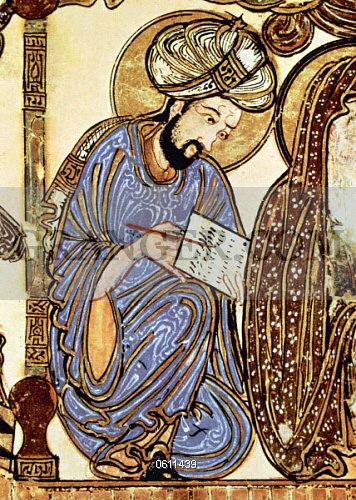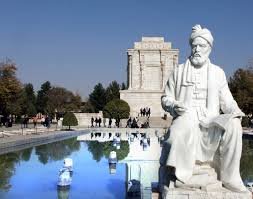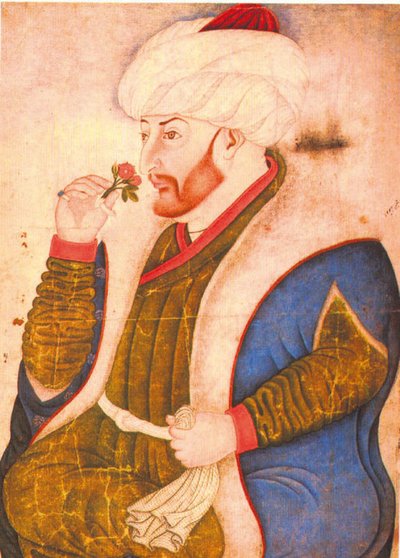Middle Eastern
The exhibit represents each of the three major poetic traditions of the Islamic Middle East: Arabic, Persian, and Ottoman Turkish. Each item also offers an example of their respective traditions of manuscript illumination.
Works

The Maqāmāt (sessions) is “a purely and typically Arabic literary genre” (Brockelmann and Pellat, Encyclopaedia of Islam) in the form of narratives of rhymed prose with the insertion of verse. The work typically relates the adventures and eloquent speeches of a picaresque hero transmitted by a narrator who is also a character, and consists of “Bedouin proverbs, learned witticisms, grammatical riddles, lexical pronouncements, original letters, ornate speeches, sermons that cause tears, and jokes that cause laughter.” The work of al-Ḥarīrī (born 1054 C.E. in Basra) came to be considered the exemplar par excellence of this genre (his introduction to his work is quoted above).
On display: two illustrations from
a thirteenth-century manuscript held in the Bibliothèque nationale de France,
portraying Abū Zayd (the hero) solving difficult riddles and al-Ḥārith
(the narrator), losing his way, coming upon Abū Zayd sleeping.
In: Nāhidah ʿAbd al-Fattāḥ Nuʿaymī, Maqāmāt al-Ḥarīrī al-muṣawwarah: dirāsah tārīkhīyah atharīyah fannīyah ([Baghdād]: al-Jumhūrīyah al-ʿIrāqīyah, Wizārat al-Thaqāfah wa-al-Funūn: Dār al-Rashīd, 1979)

The Shāhnāmah (Book of Kings) is the Persian national epic rendered in some 60,000 verse couplets composed over the course of 35 years by the poet Firdawsī (ca. 940–1020 C.E.). The exquisitely illustrated manuscript of the epic on display, held in the British Library, was produced in Herat (now in Afghanistan) in the 1440s for Muḥammad Jūkī, a descendant of Tīmūr (Tamerlane).
On display: an
illustration portraying the king Gushtāsp in battle.
In: Barbara Brend, Muhammad Juki’s Shahnamah of Firdausi (London: Royal Asiatic Society of Great Britain and Ireland: Philip Wilson, c2010)

Ottoman divan poetry embraces classical Persian and Arabic literary cultures. In this literary tradition, poets use rhetorical devices, such as metaphors, to describe complicated thoughts and feelings. In the poems, flowers are frequently used as metaphors to describe the features of the “beloved.” This is a result of Ottoman floriculture which started in the palace of the Sultan and spread through the wealthy households of Istanbul.
On display: an illustration from
an eighteenth-century manuscript. In the poem, the poet uses a very common
metaphor: the beloved is a rose, and the lover is a nightingale. The sparkling
beauty of the rose is intoxicating the nightingale, making the tulip jealous.
In: Hayati Develi, 18. yüzyıl Osmanlı kültüründen bir örnek: Çicek defteri: seçmeler (İstanbul: İstanbul Araştırmaları Enstitüsü, 2007)